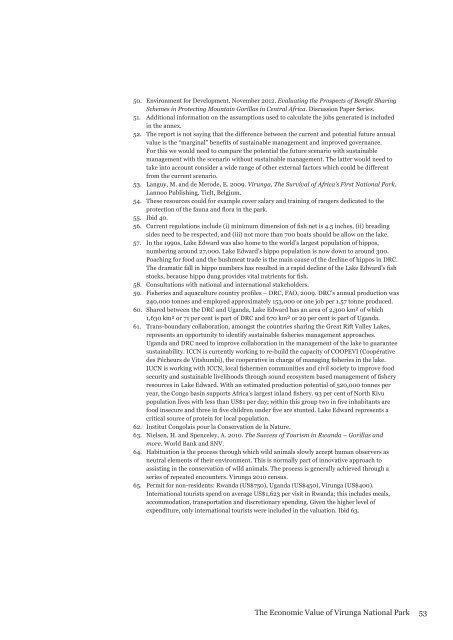The Economic Value of Virunga National Park - World Wildlife Fund
The Economic Value of Virunga National Park - World Wildlife Fund
The Economic Value of Virunga National Park - World Wildlife Fund
You also want an ePaper? Increase the reach of your titles
YUMPU automatically turns print PDFs into web optimized ePapers that Google loves.
50. Environment for Development. November 2012. Evaluating the Prospects <strong>of</strong> Benefit SharingSchemes in Protecting Mountain Gorillas in Central Africa. Discussion Paper Series.51. Additional information on the assumptions used to calculate the jobs generated is includedin the annex.52. <strong>The</strong> report is not saying that the difference between the current and potential future annualvalue is the “marginal” benefits <strong>of</strong> sustainable management and improved governance.For this we would need to compare the potential the future scenario with sustainablemanagement with the scenario without sustainable management. <strong>The</strong> latter would need totake into account consider a wide range <strong>of</strong> other external factors which could be differentfrom the current scenario.53. Languy, M. and de Merode, E. 2009. <strong>Virunga</strong>, <strong>The</strong> Survival <strong>of</strong> Africa’s First <strong>National</strong> <strong>Park</strong>,Lannoo Publishing. Tielt, Belgium.54. <strong>The</strong>se resources could for example cover salary and training <strong>of</strong> rangers dedicated to theprotection <strong>of</strong> the fauna and flora in the park.55. Ibid 40.56. Current regulations include (i) minimum dimension <strong>of</strong> fish net is 4.5 inches, (ii) breadingsides need to be respected, and (iii) not more than 700 boats should be allow on the lake.57. In the 1990s, Lake Edward was also home to the world’s largest population <strong>of</strong> hippos,numbering around 27,000. Lake Edward’s hippo population is now down to around 300.Poaching for food and the bushmeat trade is the main cause <strong>of</strong> the decline <strong>of</strong> hippos in DRC.<strong>The</strong> dramatic fall in hippo numbers has resulted in a rapid decline <strong>of</strong> the Lake Edward’s fishstocks, because hippo dung provides vital nutrients for fish.58. Consultations with national and international stakeholders.59. Fisheries and aquaculture country pr<strong>of</strong>iles – DRC, FAO, 2009. DRC’s annual production was240,000 tonnes and employed approximately 153,000 or one job per 1.57 tonne produced.60. Shared between the DRC and Uganda, Lake Edward has an area <strong>of</strong> 2,300 km² <strong>of</strong> which1,630 km² or 71 per cent is part <strong>of</strong> DRC and 670 km² or 29 per cent is part <strong>of</strong> Uganda.61. Trans-boundary collaboration, amongst the countries sharing the Great Rift Valley Lakes,represents an opportunity to identify sustainable fisheries management approaches.Uganda and DRC need to improve collaboration in the management <strong>of</strong> the lake to guaranteesustainability. ICCN is currently working to re-build the capacity <strong>of</strong> COOPEVI (Coopérativedes Pécheurs de Vitshumbi), the cooperative in charge <strong>of</strong> managing fisheries in the lake.IUCN is working with ICCN, local fishermen communities and civil society to improve foodsecurity and sustainable livelihoods through sound ecosystem based management <strong>of</strong> fisheryresources in Lake Edward. With an estimated production potential <strong>of</strong> 520,000 tonnes peryear, the Congo basin supports Africa’s largest inland fishery. 93 per cent <strong>of</strong> North Kivupopulation lives with less than US$1 per day; within this group two in five inhabitants arefood insecure and three in five children under five are stunted. Lake Edward represents acritical source <strong>of</strong> protein for local population.62. Institut Congolais pour la Conservation de la Nature.63. Nielsen, H. and Spenceley, A. 2010. <strong>The</strong> Success <strong>of</strong> Tourism in Rwanda – Gorillas andmore. <strong>World</strong> Bank and SNV.64. Habituation is the process through which wild animals slowly accept human observers asneutral elements <strong>of</strong> their environment. This is normally part <strong>of</strong> innovative approach toassisting in the conservation <strong>of</strong> wild animals. <strong>The</strong> process is generally achieved through aseries <strong>of</strong> repeated encounters. <strong>Virunga</strong> 2010 census.65. Permit for non-residents: Rwanda (US$750), Uganda (US$450), <strong>Virunga</strong> (US$400).International tourists spend on average US$1,623 per visit in Rwanda; this includes meals,accommodation, transportation and discretionary spending. Given the higher level <strong>of</strong>expenditure, only international tourists were included in the valuation. Ibid 63.<strong>The</strong> <strong>Economic</strong> <strong>Value</strong> <strong>of</strong> <strong>Virunga</strong> <strong>National</strong> <strong>Park</strong> 53
















